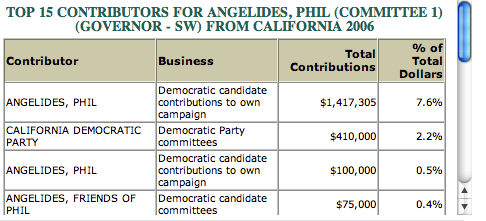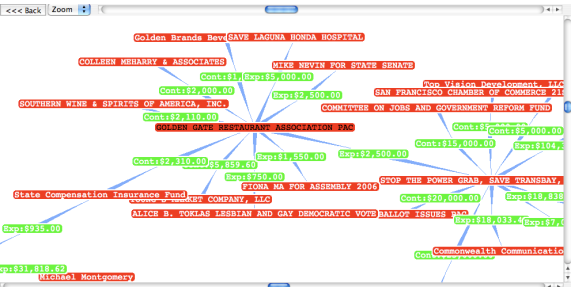Daniela Kirshenbaum recently wrote an article at Fog City Journal describing how some of the business interests in San Francisco effect the city’s politics. It’s a great article based on a lot of research and connecting the dots between a lot of people and organizations. I’m going to use it as an example of how on-line articles have the potential for adding a lot more context to a story than they do now. About how people should be linkable just like web pages.
Here’s how things work today: A writer, blogger, emailer, or journalist like Daniela writes something. In it, she refers to people with plain text, e.g.,
Donald Fisher of the Gap is a strong voice in San Francisco politics.
The readers of the article then go through the following process: they see names and organizations in the article, they’d like to know more about them, e.g., ‘who is this Donald Fisher?’. So they google him, and Google shows them some pertinent articles, but also old stuff, and stuff about other Donald Fishers, etc. The readers sift and filter through it. If the reader is a journalist or some other serious researcher, perhaps they bookmark the articles pertinent to Donald Fisher the Gap owner. But all the readers do this same ‘filtering’ work, this same Googling. Over and over. They don’t share their research work.
A Better Solution
Wouldn’t it be better if the writer of an article could help her readers out by making the ‘Donald Fisher’ reference in the article point to more information about thee Donald Fisher being talked about, i.e., put a link to a page with the important articles about Donald Fisher. Then the readers wouldn’t have to all Google him to see more, and all that individual filtering work could be eliminated. Plus they could just click on a link as opposed to typing in a name at Google or in a google box. Context for the article would be at their fingertips.
Of course the question arises: to where should the author link the text ‘Donald Fisher’. His wikipedia page is one possibility. So she could change her sentence to:
Donald Fisher of the Gap is a strong voice in San Francisco politics.
This solution is pretty good. The readers, if they want to learn more about this person, can click on the link and get to at least a starting point about Donald Fisher.
But this wikipedia-based solution has some limitations. Not everyone is in wikipedia. Its a world encyclopedia and is at least somewhat thought of as about universally famous people. Fisher is in it, but his page is pretty bare and generic. There’s certainly not any links to articles giving context to how he effects SF politics.
Now a writer could go to wikipedia and add more, and wikipedia will certainly grow as time rolls on. But editing a wikipedia page, though accessible to most computer users, is still a task. Most of us don’t do it. So generally speaking, most people on this earth aren’t in there or, if they are, there isn’t much.
Peoplicious is a suite of web applications with a goal of providing a better solution. Peoplicious sites are domain-specific. The one pertinent to this discussion is about Bay Area politicos and can be reached at http://opencampaigns.com. Its domain-specific nature allows for focus, e.g., the articles concerning Donald Fisher at opencampaigns.com pertain to his effect on San Francisco politics.
Like wikipedia, it is also a site where anyone can add information. However, submitting information to the system is as easy as bookmarking– a user can add an article to a person’s page with about three clicks. Besides articles, one can also add a person’s homepage, their blog if they have one, an image– all the basic information that make up a person’s virtual persona. The idea is that, because it is so easy to add information about a person and anyone can do it, the pages for each person will stay relatively up-to-date. People can share their googling work and make use of the work done by others.
Take for instance Fisher’s page. Users (well, me) have added a number of articles to it. If Kirshenbaum used Fisher’s opencampaigns page as the link, our sample sentence would appear as:
Donald Fisher of the Gap is a strong voice in San Francisco politics.
Click on the above link. The page that appears has recent articles concerning Fisher and pertaining to Bay Area politics.
O.K., great, you say. Let’s say enough users get involved so that opencampaigns grows and stays up-to-date. Isn’t it still laborious for journalists to add links in their articles to the people they reference? The answer is yes. In fact, I did this for Kirshenbaum’s article, you can find the version with links at http://www.cs.usfca.edu/~wolber/politics/kirshenbaum_061015.shtml. It took me ten minutes and it was boring. The last thing a writer will want to do after completing an article is go through and insert these links.
If you’re a journalist, you might be thinking ‘intern’ or ‘secretary’. I’m a computer scientist, so as I was doing the laborious work I thought: hey, software can do this for us! My plan is to write some software that will take an html verison of an article, cross reference the names in it with the opencampaigns database, and automatically add links to the article. Of course the writer will have to check the links for pseudonym problems, but given the domain-specific nature of the data, there should be none or just a few. So adding people-context links to an article can be pretty much effortless.
Summary
I’m a USF computer science professor, and here’s my vision. opencampaigns.com becomes a place where, as a community, we collect articles and categorize them under the people they are about. Journalists then use software (which I will write) to automatically add links to people pages in their on-line articles. In this manner, the articles at sfgate, the examiner, beyondchron, etc. are transformed from independent textual islands to context-rich sources of knowledge.
The public becomes more knowledgeable, politics become more transparent, and maybe, just maybe, our politicians and ‘business leaders’ behave a little better.
You can contact me at wolber@usfca.edu







